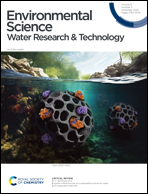Legionella pneumophila occurrence in reduced-occupancy buildings in 11 cities during the COVID-19 pandemic†
Abstract
In spring 2020, numerous buildings were closed or operated at reduced occupancies to slow the spread of COVID-19. An unintended consequence of these social distancing measures was a reduction in water demand in many buildings. Concerns arose that contaminants associated with water stagnation, such as Legionella pneumophila, could become prevalent. To investigate the potential public health risk associated with L. pneumophila, samples from 26 reduced-occupancy buildings in 11 cities in the United States, Canada, and Switzerland were analyzed for L. pneumophila using liquid culture (Legiolert, n = 258) and DNA-based methods (qPCR/ddPCR, n = 138). L. pneumophila culture-positivity was largely associated with five buildings, each of which had specific design or operational deficiencies commonly associated with L. pneumophila occurrence. Samples from buildings with free chlorine residual disinfection had higher culture-positivity (37%) than samples from buildings with chloramine (1%). Additionally, 78% of culture-positive samples occurred when the disinfectant residual was ≤0.1 mg L−1 Cl2 and only three free chlorine samples were culture-positive when the disinfectant residual was >0.2 mg L−1 as Cl2. Although overall sample positivity using culture- and DNA-based methods was equivalent (34% vs. 35%), there was disagreement between the methods in 13% of samples (n = 18 of 138). Few buildings reported any water management activities, and L. pneumophila concentrations in flushed samples were occasionally greater than in first-draw samples. This study provides insight into how building plumbing characteristics and water management practices contribute to L. pneumophila occurrence during low water use periods and can inform targeted prevention and mitigation efforts.

- This article is part of the themed collections: Environmental Science: Water Research & Technology Hot Papers, Outstanding Papers 2023 – Environmental Science: Water Research & Technology and Recent Open Access Articles


 Please wait while we load your content...
Please wait while we load your content...